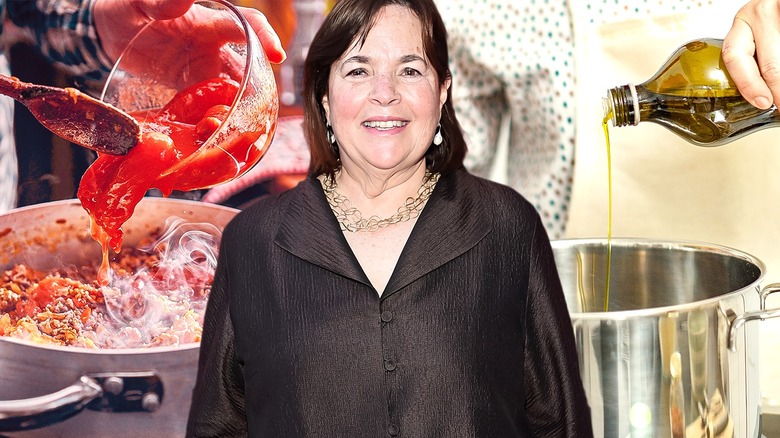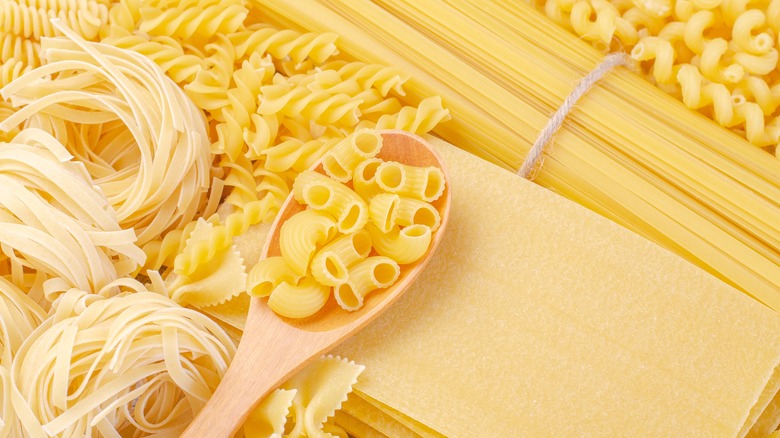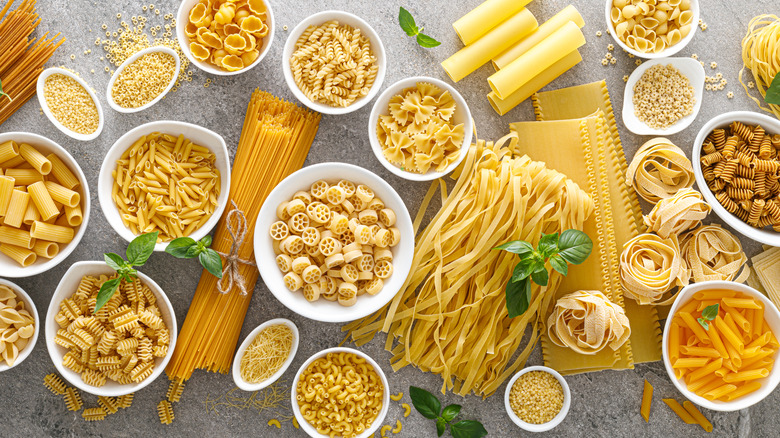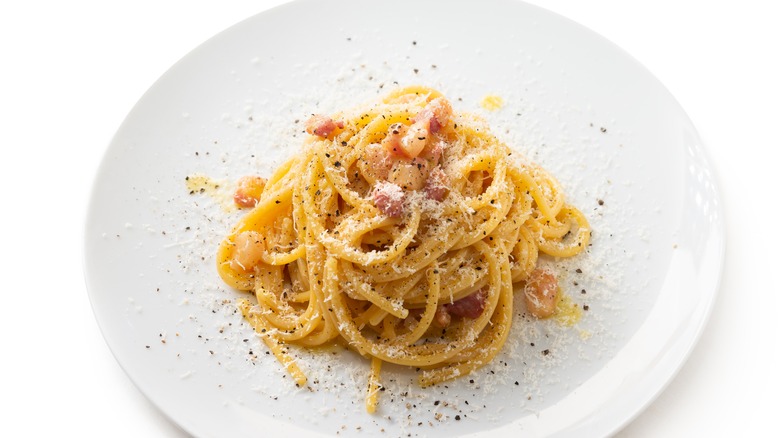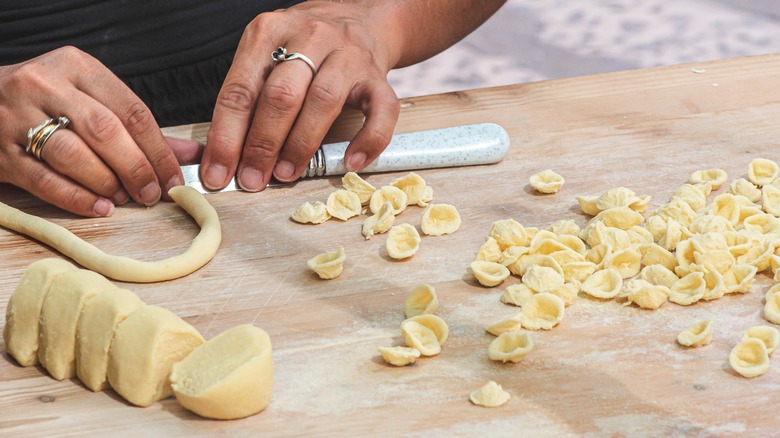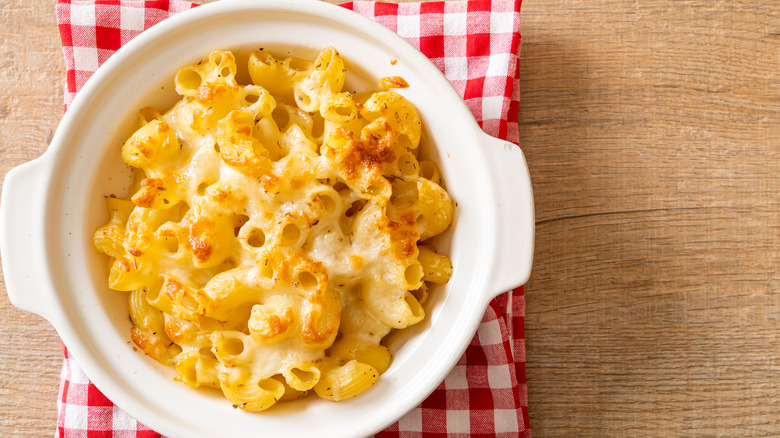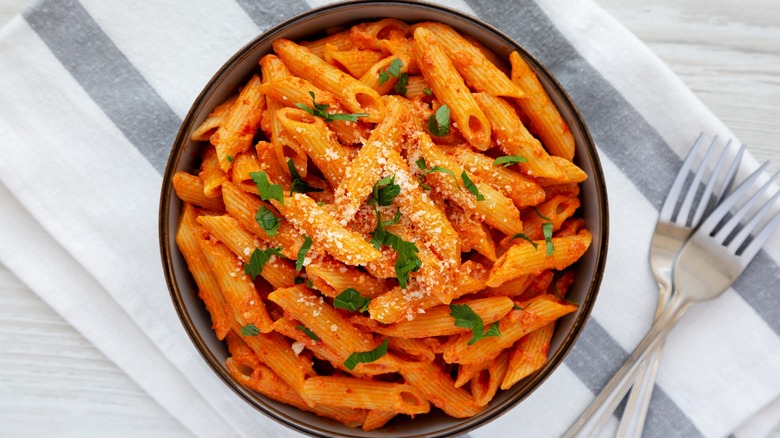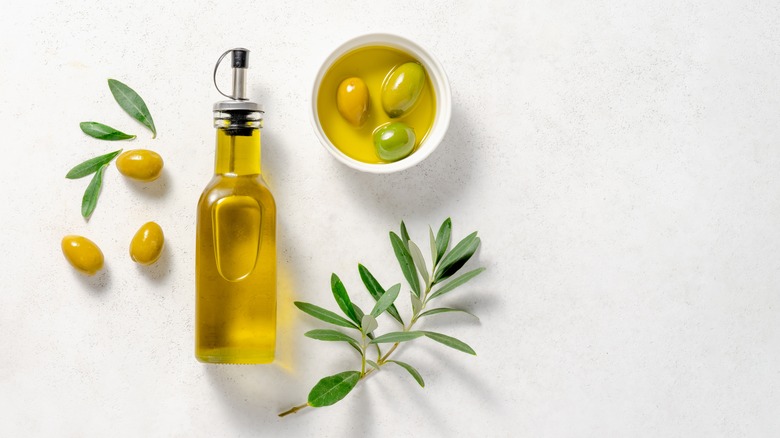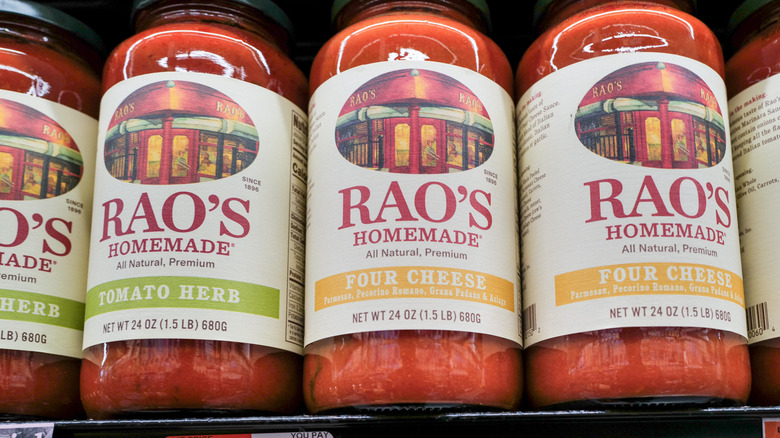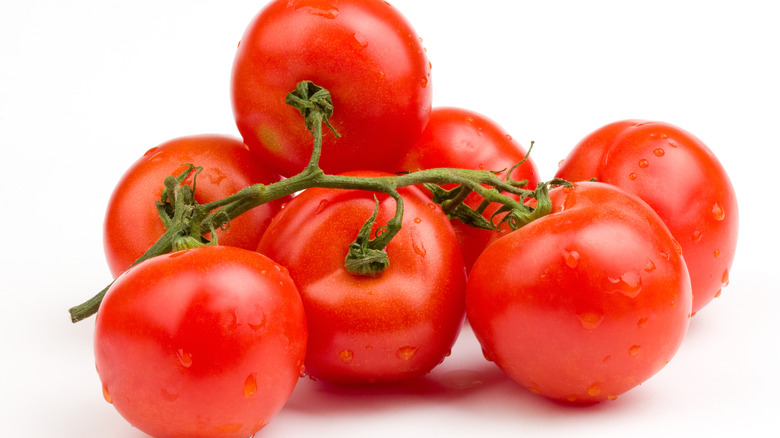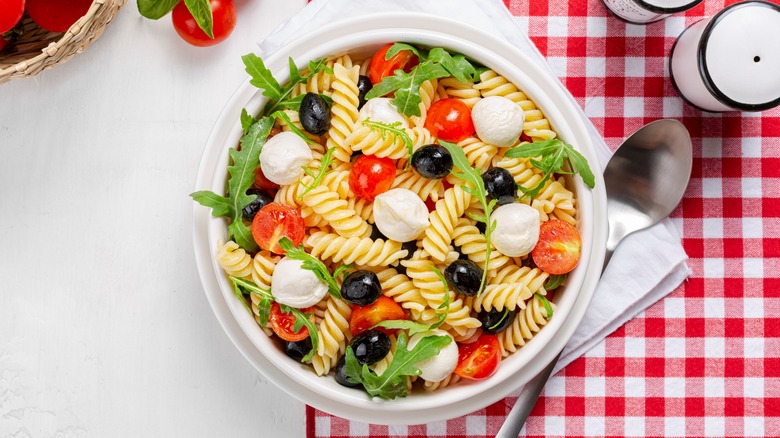Ina Garten's 10 Best Tips For Cooking Pasta
Ina Garten can make pretty much anything well, except maybe for Boston cream pie, a recipe she doesn't feel she's perfected just yet. Not only that, but she excels at making a wide variety of dishes, from simple roast chicken with citrus to French potato salad, all of which tend to be accessible for the home cook yet beguiling to the sophisticated palate. This talent naturally includes Garten's propensity for making stellar pasta dishes, with her recipes going above and beyond just boiling noodles and tossing in the sauce of the day. As usual, Ina Garten takes pasta to the next level by adding flavor to dishes you didn't know could pack such a punch.
But enough talk. Let's take a look at some proof. To that end, we've compiled a list of some of Ina's best tips on how to cook pasta the right way. And if you follow her advice, you can finally say goodbye to limp noodles, sticky pasta, sauce snafus, and all the other pasta debacles you've faced over the years. If you're lucky, you may even find solutions to pasta problems you didn't even know you had. Let's take a look at how Ina Garten has once again pulled off a magic trick and made all kinds of pasta recipes accessible to us –- even to those hopeless home cooks who can barely boil water.
Mix up different pasta shapes
You've heard of spaghetti, fettuccine, penne, and maybe even fusilli. These are just a few of Italy's most famous and commonly found pasta shapes. They're the ones that made it across the Atlantic early on, gracing tables at Italian restaurants across the U.S. and providing something to sink our teeth into whenever we try a new Italian sauce.
But the truth is that if you've heard of those and no other pastas, you've barely scratched the surface; there are actually well over 300 different types of pasta shapes in Italy, many of which are only available within the local regions whence they come. Garganelli, for example, are an egg-based pasta that gets rolled up into a funnel and come dented along the sides like flexible tubing. Meanwhile, gigli, a type of pasta from Tuscany, are shaped like lilies, as the name suggests in Italian.
Is your mind blown yet? One of the Barefoot Contessa's best tips for cooking pasta involves a step that will help widen your pasta horizons. Indeed, Garten recommends mixing up different pasta shapes in order to add texture to a dish. The trick is to use pasta shapes of similar size, and the bonus is that you can use up leftover boxes that no longer have full portions remaining.
Cook with top quality pasta
Pasta may seem like an ingredient that is reliably good every time you make it. But in reality, not all pasta was created equal. Some brands are better than others. If you've ever bought the cheapest box at the cheapest bodega down the street, only to find that the noodles glommed onto each other during cooking, never to come apart again, then you know what we're talking about. Ina Garten also knows, which is why she always keep two quality boxed pastas in her pantry.
Luckily, at least one of her top choices is widely available in U.S. supermarkets. As she told Bon Appetit in 2018, De Cecco pasta is one of her top favorites, and she always keeps a few boxes on hand. You, too, can stock your pantry this way. Most grocery stores carry this brand in several shapes, including spaghetti and penne. For something a bit more luxurious, Garten prefers Cipriani Tagliarelle, which has the benefit of tasting like fresh pasta but with the shelf life of dried.
Add vegetables to carbonara
If you're in the mood for a robust, filling meal that hits all the right spots, pasta alla carbonara is hard to beat. Between the pancetta bits, eggs, parmesan cheese, and heavy cream (sometimes), it's the perfect post-marathon meal or dish for when you feel like you haven't eaten in days. But Ina Garten's recipe gives carbonara a fresh twist, proving you can still enjoy elements even if you're looking for something a little lighter, or if you want to include something healthy in this den of iniquity of a meal. Her version involves adding vegetables, and although these may seem counter to the spirit of the food, the move actually works.
To prepare it, you'll still need to line up your bacon, eggs, and parmesan, but on top of that, you'll need snow peas, fresh peas, asparagus, scallions, and chives. You will cook these in the water you use for the pasta, but make sure you don't throw them in until the end. The key to success here is to make sure the vegetables remain fresh and crispy and not soft and overcooked. This will give your dish a nice crunch, on par with the pancetta. Before serving, mix in some lemon juice and lemon zest for extra lightness. This dish will still have all the elements of a carbonara, but with the added freshness it'll be practically unrecognizable, in a good way.
Serve bolognese sauce on orecchiette
You may have heard by now that spaghetti bolognese is an American invention. Although the ragu bolognese sauce is definitely from Bologna, Italy, and origin of spaghetti is also undeniably from Italy, this particular pasta to sauce pairing is one of those dishes with a conflicting history. Bologna in fact, is in the Emilia Romagna region in the north, while spaghetti hails from Sicily, in the south. In the real-life Italy of centuries past, these two elements would hardly have had a chance to meet. Instead, Bolognese was served with fresh tagliatelle pasta, which is firmly native to Emilia Romagna, and to which the sauce sticks nicely.
As such, you should feel more than justified in your decision to pair Bolognese sauce with any pasta shape you like. No need to stick to spaghetti, since that wasn't the original intention anyway. Ina Garten suggests using bolognese with orecchiette pasta, the delightful little pasta shapes that look like ears, or orecchie, in Italian. These are also easy to make fresh, as shaping them only requires a deft thumb movement. The sauce adheres nicely, sometimes gathering in the little nook they form in the middle.
Soak mac and cheese overnight
Mac and cheese is such an American staple that one would think it was quick and easy to make. After all, quick and easy seem to be the hallmarks of American cuisine. But mac and cheese is deceptive; it can take several hours to make and requires many more steps than your everyday pasta dish. Even some of the simplest mac and cheese recipes can take a good 40 minutes to prepare and involve the wrist-defying action of creating a béchamel sauce from scratch.
So don't be surprised when you learn that Ina Garten suggests soaking your mac and cheese overnight. This involves cooking your pasta and then leaving it to stew in some heavy cream, nutmeg, and grated cheese for at least 24 hours –- enough time for the pasta to become soaked through. Although this method may seem lengthy, it helps your mac and cheese become creamy without the use of béchamel, so in a way, it's a simpler method for making this dish. After the soaking period is complete –- which requires absolutely no oversight at all –- the only thing you have to do is bake your macaroni in the oven as you normally would. Just make sure that if you're planning any mac and cheese additions, like kimchi or broccoli, you add these to the pasta after the soaking process. Vegetables risk falling apart in the process.
Bake the sauce for pasta alla vodka
Most pasta sauces are meant to be cooked on the stove –- you start with a nice base of chopped onions, probably some crushed garlic, likely some oregano or other spice, and invariably some form of tomato, whether fresh, canned, or as a paste. And when it comes to Ina Garten's vodka sauce, the ingredient list is more or less there, plus the vodka. But what stands out about Garten's vodka sauce recipe is the fact that she bakes it in the oven instead of cooking it on the stove.
Or rather, she cooks it in the oven in addition to on the stove. Her trick, really, is to cook it twice: first, saute your ingredients, then cover the pot tightly and stick it in the oven. Once the sauce is hot and bubbly, blend it until completely smooth, after which it's time to add spices, seasoning, and heavy cream. Finally, stir in the penne, cooked al dente, along with some freshly grated parmesan. For this trick, you can follow Ina's own recipe, but the beauty of it is that you can actually pull this off with any vodka sauce recipe, including a classic version. Just don't forget to preheat the oven while you saute the ingredients and stick your pot in after adding the crushed tomatoes but before including the heavy cream. That's how you make a flavor-packed, texture-rich penne alla vodka.
Bathe your ingredients in olive oil
A quality olive oil can do a lot of the heavy lifting in a recipe, especially in terms of flavor. Bad olive oil is generally a no-go, as it can make things feel greasy and taste heavy; so-so olive oil can sometimes have its place in the early stages of a recipe, where the oil is needed for sauteing but where little of its flavor will be retained through to the final result. But nothing less than good quality olive oil, such as a high-end extra virgin olive oil, is required if you want to use it as the centerpiece of your recipe.
This is exactly the kind of product you should be reaching for when you follow Ina Garten's secret for summer pasta. Her advice is to bathe your pasta ingredients in olive oil, and not only that, but to should make sure you select good produce too. In this case, that involves basil, garlic, and tomatoes. Once you have all your top-quality ingredients on hand, it's time to start the soaking: place all the items in a bowl and allow them to sit together for at least four hours, getting to know each other. And remember: because you're not doing any fancy tricks to these ingredients, quality is key.
Use premium tomato sauce
We talk a lot about the importance of good quality ingredients in cooking, but that's because it really matters, and the fact just can't be overstated. Ina Garten seems to agree because one of her top tips for cooking pasta is to use exceptional pasta sauce. A homemade sauce prepared lovingly with good ingredients is likely to fit the bill, but according to Garten, it doesn't have to be as complicated as that. You may have heard that Ina Garten doesn't mind using store-bought ingredients in many cases, and tomato sauce happens to be one of those cases.
All you have to do to make a good pasta dish is select the right tomato sauce. The store-bought sauce that Ina Garten swears by is Rao's marinara sauce, which is available in many supermarkets across the U.S. It comes in several variations, including arrabbiata and roasted garlic, but the trick to using this sauce properly is to get the most rudimentary form and deploy it as a base for a more involved recipe. Indeed, Garten has found that this marinara sauce lends itself well to making lasagna and eggplant parmesan, but you don't have to stop there. It can also be used to simplify your shakshuka or as the tomato base for your next homemade pizza.
Add sauteed cherry tomatoes
Cherry tomatoes are the darlings of the tomato world. They're cute, easy to cook with, packed with flavor, and if you've ever tasted one right off the vine, you might have thought it was candy. It's no wonder, then, that Ina Garten often incorporates sauteed cherry tomatoes into her cooking, including as a way to improve her pasta dishes. One of her best recipes calls for these tomatoes to be simply sauteed along with garlic, thyme, salt, pepper, and red pepper flakes. Throw in some basil and parsley at the end, and your impromptu tomato sauce is done. All that's left to do is toss it with the pasta and top it with grated parmesan.
This little tomato trick is too good to use in just one recipe. A polenta with cherry tomatoes recipe shows just how versatile sauteed cherry tomatoes can be. All you have to do is saute them as you would for the pasta and drop a few spoonfuls of the finished sauce onto a plate of polenta. And because you're probably sensing a theme here, we're going to go ahead and say it: try this trick with pretty much any starch, including baked potatoes or toast!
Use leftovers for pasta salad or pasta sauce
If you want your kitchen to be more sustainable, or simply if you want to save money and make sure you use up all your ingredients before buying new ones, it might behoove you to learn how to best deploy your leftovers to make pasta salad or pasta sauce.
Ina Garten's recipe for tomato and feta pasta salad is an insider tip for leftovers This tasty dish stands in sharp contrast to the legions of flavorless pasta salads you may have sampled at family potlucks. Although it can be made with any leftover pasta that didn't make it into the sauce last night, you'll also need a whole team of salty ingredients to make sure the flavor stays put. Consider black olives, feta, sun-dried tomatoes, capers, and a whole cup of grated Parmesan. You can balance it with a splash of red wine vinegar, which seals the deal and gives new life to leftovers.
Meanwhile, you can also use any leftover soup and turn it into pasta sauce. On her website, the Barefoot Contessa suggests taking any uneaten tomato and eggplant soup, which includes a bevy of classic tomato sauce ingredients, and adding it to a baked pasta dish. Simply add cooked pasta to the soup along with some mozzarella, Parmesan, and seasoning, and bake the mixture together.
